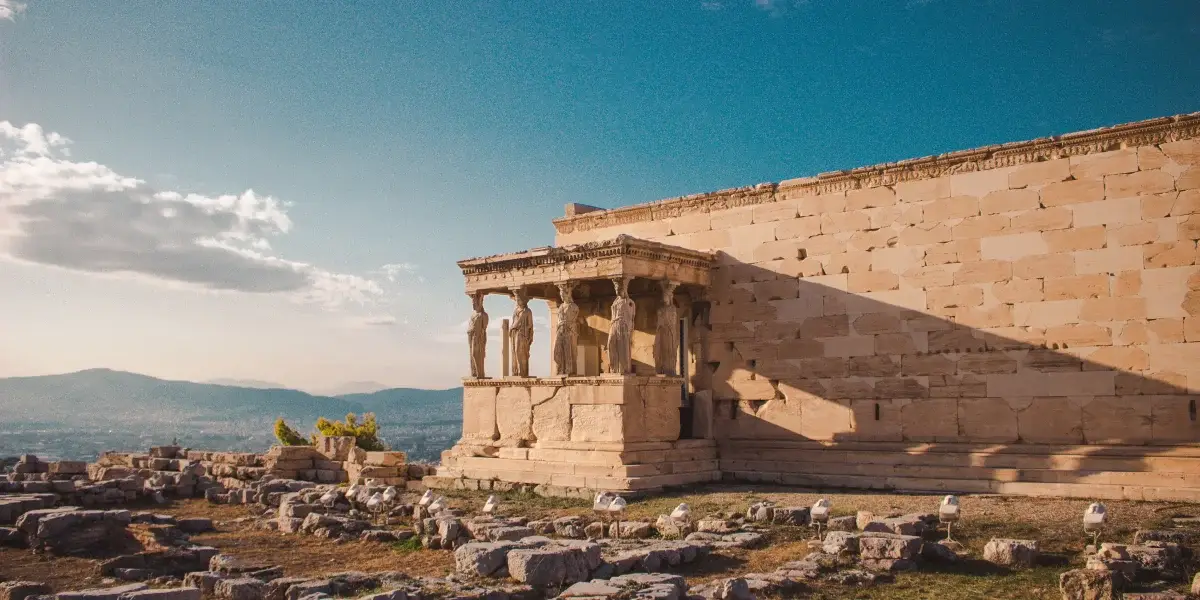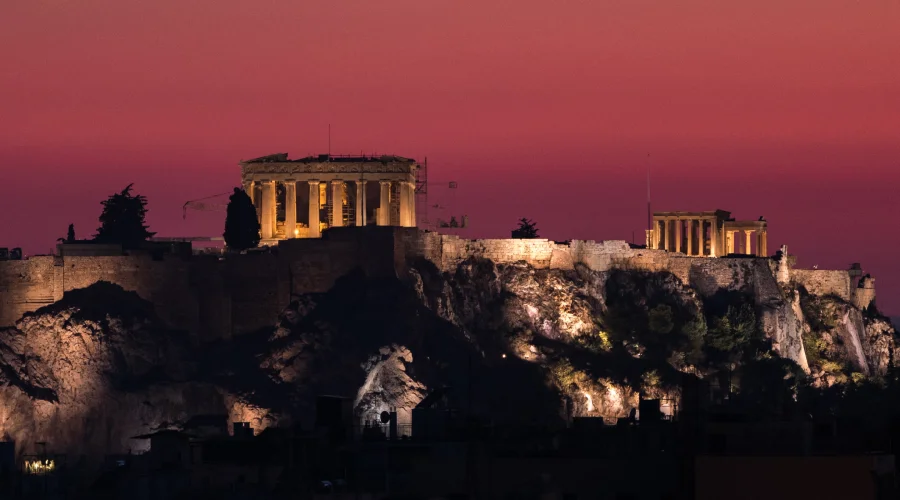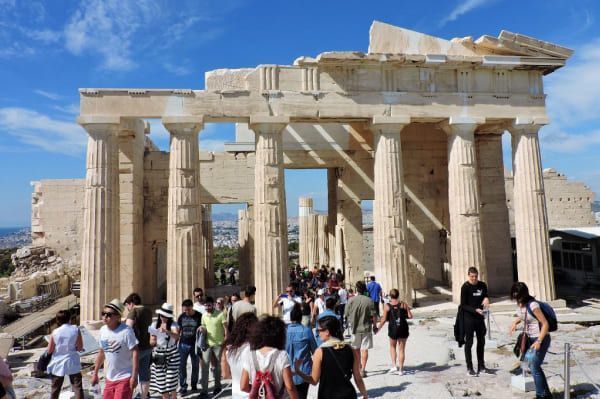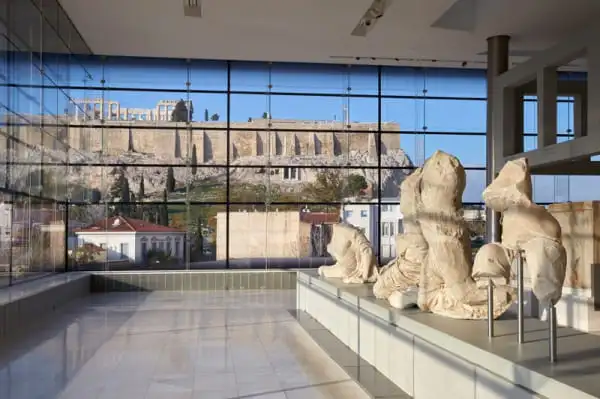
 Architectural Marvels
The Acropolis boasts a stunning array of architectural marvels. The Parthenon, the most famous temple on the Acropolis, is an exemplar of classical Greek architecture. Its meticulously designed Doric columns and intricate sculptural details make it an awe-inspiring sight. Other structures, such as the Erechtheion with its iconic Caryatid statues, showcase the intricacy and artistry of ancient Greek building techniques.The Parthenon: An Emblem of Antiquity
The Parthenon, perched atop the Athenian Acropolis, is one of the most celebrated architectural masterpieces in the world. Constructed in the 5th century BCE, this Doric temple dedicated to the goddess Athena is a symbol of classical beauty. Its harmonious proportions, graceful columns, and intricate sculptural details continue to inspire architects, artists, and visitors from around the globe. The Parthenon’s enduring legacy is a testament to the elegance and ingenuity of ancient Greek design.The Acropolis Museum: A Modern Gem
While honoring Athens’ rich past, the city also embraces modern architectural gems. The Acropolis Museum, designed by architect Bernard Tschumi, is a striking example of contemporary design. Situated at the foot of the Acropolis, this museum features a transparent, light-filled structure that allows visitors to view the archaeological remains beneath while showcasing an impressive collection of ancient artifacts. It is a harmonious blend of old and new, providing a deeper understanding of Athens’ history.
The National Library of Greece: Neoclassical Elegance
The National Library of Greece, part of the Neoclassical Trilogy of Athens along with the University of Athens and the Academy of Athens, is a study in architectural elegance. Built in the 19th century, this neoclassical gem showcases stately columns, intricate facades, and a sense of intellectual grandeur. It remains a testament to the city’s cultural and academic heritage.
The Stavros Niarchos Foundation Cultural Center: A Modern Cultural Hub
The Stavros Niarchos Foundation Cultural Center, designed by renowned architect Renzo Piano, is a contemporary masterpiece that combines art, culture, and sustainability. Situated in the Kallithea district, the complex houses the Greek National Opera and the National Library of Greece. Its environmentally friendly features, including a green roof and solar panels, demonstrate a commitment to both cultural enrichment and ecological responsibility.
The Panathenaic Stadium: An Ancient Arena
The Panathenaic Stadium, also known as the Kallimarmaro, is an extraordinary ancient structure that has been beautifully preserved. Originally built in the 4th century BCE and later reconstructed in marble by the Romans, it hosted the first modern Olympic Games in 1896. This monumental stadium, constructed entirely of white marble, offers visitors a chance to step back in time and experience the ancient games.
A City of Architectural Diversity
Athens, a city that has withstood the test of time, is a living testament to the remarkable diversity of architectural styles, from the classical to the contemporary. These architectural marvels serve as a reminder of the enduring allure of Athens, where history and innovation coexist harmoniously. Whether you’re strolling through the ancient streets or admiring modern masterpieces, Athens’ architectural wonders invite you to appreciate the beauty and complexity of this vibrant city.
Architectural Marvels
The Acropolis boasts a stunning array of architectural marvels. The Parthenon, the most famous temple on the Acropolis, is an exemplar of classical Greek architecture. Its meticulously designed Doric columns and intricate sculptural details make it an awe-inspiring sight. Other structures, such as the Erechtheion with its iconic Caryatid statues, showcase the intricacy and artistry of ancient Greek building techniques.The Parthenon: An Emblem of Antiquity
The Parthenon, perched atop the Athenian Acropolis, is one of the most celebrated architectural masterpieces in the world. Constructed in the 5th century BCE, this Doric temple dedicated to the goddess Athena is a symbol of classical beauty. Its harmonious proportions, graceful columns, and intricate sculptural details continue to inspire architects, artists, and visitors from around the globe. The Parthenon’s enduring legacy is a testament to the elegance and ingenuity of ancient Greek design.The Acropolis Museum: A Modern Gem
While honoring Athens’ rich past, the city also embraces modern architectural gems. The Acropolis Museum, designed by architect Bernard Tschumi, is a striking example of contemporary design. Situated at the foot of the Acropolis, this museum features a transparent, light-filled structure that allows visitors to view the archaeological remains beneath while showcasing an impressive collection of ancient artifacts. It is a harmonious blend of old and new, providing a deeper understanding of Athens’ history.
The National Library of Greece: Neoclassical Elegance
The National Library of Greece, part of the Neoclassical Trilogy of Athens along with the University of Athens and the Academy of Athens, is a study in architectural elegance. Built in the 19th century, this neoclassical gem showcases stately columns, intricate facades, and a sense of intellectual grandeur. It remains a testament to the city’s cultural and academic heritage.
The Stavros Niarchos Foundation Cultural Center: A Modern Cultural Hub
The Stavros Niarchos Foundation Cultural Center, designed by renowned architect Renzo Piano, is a contemporary masterpiece that combines art, culture, and sustainability. Situated in the Kallithea district, the complex houses the Greek National Opera and the National Library of Greece. Its environmentally friendly features, including a green roof and solar panels, demonstrate a commitment to both cultural enrichment and ecological responsibility.
The Panathenaic Stadium: An Ancient Arena
The Panathenaic Stadium, also known as the Kallimarmaro, is an extraordinary ancient structure that has been beautifully preserved. Originally built in the 4th century BCE and later reconstructed in marble by the Romans, it hosted the first modern Olympic Games in 1896. This monumental stadium, constructed entirely of white marble, offers visitors a chance to step back in time and experience the ancient games.
A City of Architectural Diversity
Athens, a city that has withstood the test of time, is a living testament to the remarkable diversity of architectural styles, from the classical to the contemporary. These architectural marvels serve as a reminder of the enduring allure of Athens, where history and innovation coexist harmoniously. Whether you’re strolling through the ancient streets or admiring modern masterpieces, Athens’ architectural wonders invite you to appreciate the beauty and complexity of this vibrant city.
A Glimpse into Ancient Mythology
Athens, the cradle of Western civilization, is not only celebrated for its historical and architectural marvels but also for its deep connection to ancient mythology. The city’s streets and landmarks are steeped in the myths and legends of the Greek gods and heroes, providing a captivating glimpse into the rich tapestry of stories that have shaped human imagination for centuries. Let’s embark on a journey to explore how ancient mythology is interwoven with the very fabric of Athens. The Acropolis: Home to the Gods The Acropolis, Athens’ most iconic landmark, is not only a testament to architectural excellence but also a sacred place deeply associated with ancient Greek mythology. The Parthenon, dedicated to the goddess Athena, stands as a shining example of this connection. According to mythology, Athena and Poseidon, the god of the sea, vied for the patronage of the city. Athena’s gift of the olive tree, symbolizing peace and wisdom, secured her place as the city’s protector, and the Parthenon became her enduring temple. The Erechtheion: A Mythological Marvel Adjacent to the Parthenon, the Erechtheion is another ancient temple on the Acropolis dedicated to the mythical king Erechtheus, the legendary founder of Athens. The temple’s design reflects the amalgamation of various legends, including the contest between Athena and Poseidon and the stories of Erechtheus and Kekrops. The Erechtheion’s unique architecture and its association with these myths make it a significant cultural and architectural treasure. Agora: Where Legends Walked The Ancient Agora of Athens, a marketplace and civic center in classical times, was not only a hub of daily life but also a place where legends unfolded. It was here that Socrates, the famed philosopher, engaged in his dialogues and teachings. Socrates’ wisdom and moral philosophy continue to influence the world’s intellectual discourse. Odeon of Herodes Atticus: A Stage for the Arts This ancient amphitheater, located on the southwest slope of the Acropolis, has played a crucial role in the city’s cultural history. Named after Herodes Atticus, a wealthy Athenian aristocrat, it was a venue for musical and theatrical performances in ancient times. The stories of gods and heroes often took center stage, providing entertainment, inspiration, and a deeper connection to mythology for the audience. Statues and Artifacts: Guardians of Myth Museums and archaeological sites in Athens are home to a plethora of statues, pottery, and artifacts that bring ancient myths to life. Whether it’s sculptures of gods and goddesses, depictions of epic battles, or symbols of heroism, these pieces offer a tangible link to the city’s mythological past. Mythology’s Influence Today In modern Athens, the myths and legends of ancient Greece continue to be celebrated in various forms. They are a source of artistic inspiration, educational exploration, and a reminder of the enduring relevance of these timeless tales. Whether in literature, art, or contemporary culture, the stories of gods and heroes continue to captivate and enrich the lives of Athenians and visitors alike. In conclusion, a glimpse into ancient mythology in Athens is an opportunity to unravel the layers of history, art, and culture that have shaped this city into a living museum of the ancient world. As you explore its streets and landmarks, you’re not only retracing the footsteps of gods and heroes but also delving into the depths of human imagination and storytelling. Athens is not merely a city of history; it is a city where the myths of the past continue to breathe life into the present, creating a timeless and enchanting tapestry that beckons all to explore its mysteries.
Panoramic Views of Athens
Athens, the capital of Greece, is a city of unparalleled historical significance and architectural marvels. Nestled amidst the hills and valleys of Attica, Athens offers a remarkable experience not only at ground level but also from above. Panoramic views of the city, whether from hilltops, historic landmarks, or modern rooftop terraces, provide a unique vantage point from which to appreciate the sprawling metropolis and its captivating surroundings. Let’s ascend to new heights and explore the breathtaking panorama of Athens. The Athenian Acropolis: A Timeless Perspective Perched on a rocky hill, the Athenian Acropolis offers a panoramic view that transports you back in time. As you ascend this ancient citadel, you’ll witness not only the awe-inspiring architectural wonders of the Parthenon and Erechtheion but also a stunning vista of the city below. The Acropolis provides a timeless perspective, inviting you to admire the marriage of ancient and modern Athens. Mount Lycabettus: The City at Your Feet For a bird’s-eye view of Athens, there’s no better vantage point than Mount Lycabettus. Ascend this iconic hill, whether by funicular or on foot, and you’ll be rewarded with a panoramic view that stretches from the Saronic Gulf to the Athenian Riviera. As the sun sets, the city’s lights begin to twinkle, creating a mesmerizing sight. It’s an ideal spot for a romantic evening or a moment of solitude and reflection. The National Observatory of Athens: Stars and Skylines The National Observatory of Athens, perched on the Hill of the Nymphs near the Acropolis, offers not only celestial observations but also breathtaking views of the city. From this unique vantage point, you can gaze at the illuminated Acropolis and the sprawling cityscape under the vast Athenian sky. It’s a harmonious blend of ancient history and modern urbanity. The Stavros Niarchos Foundation Cultural Center: Modern Elegance The Stavros Niarchos Foundation Cultural Center, designed by Renzo Piano, is a testament to modern architecture and innovation. This cultural hub in Kallithea, south of the city center, features a stunning green roof that serves as a grand terrace. From here, you can enjoy a panoramic view of both the city and the sea, providing a fresh perspective on Athens’ contemporary beauty. Rooftop Bars and Restaurants: A Culinary Panorama Athens boasts an array of rooftop bars and restaurants, each offering a unique culinary panorama. Enjoying a meal or a drink while taking in the city’s skyline is a delightful way to experience Athens from above. From the historic district of Plaka to the chic neighborhoods of Kolonaki and Psiri, rooftop venues provide a modern twist on the traditional Greek dining experience. In conclusion, panoramic views of Athens offer a new perspective on a city that has witnessed the rise and fall of empires, the birth of democracy, and the evolution of culture and civilization. Whether you’re gazing at the ancient ruins from the Acropolis, embracing the sparkling lights from Mount Lycabettus, or enjoying the modern elegance of the Stavros Niarchos Foundation Cultural Center, each viewpoint provides a unique lens through which to appreciate the beauty and complexity of Athens. These panoramas tell the story of a city where history, innovation, and natural beauty coexist, creating a tapestry of experiences that beckon all to explore from above.
A Journey Back in Time
Athens, the cradle of Western civilization, is a city where history comes to life at every turn. As you wander through its ancient streets and gaze upon its timeless landmarks, you embark on a journey that transcends centuries and offers a profound glimpse into the roots of our modern world. Athens is not merely a city; it’s a portal to the past, a journey back in time that invites you to explore the historical tapestry of humanity. The Acropolis: Where Gods and Mortals Meet The Acropolis, with its majestic Parthenon, is the epitome of Athens’ historical significance. Perched atop a rocky hill, this ancient citadel is a place where gods and mortals met, and where the principles of democracy, philosophy, and art were born. Walking through its sacred grounds, you can almost hear the voices of philosophers like Plato and Aristotle and envision the grand processions of the Panathenaic Games. The Acropolis is not just a collection of ruins; it’s a bridge that connects us to the intellectual and cultural richness of the past. The Ancient Agora: The Heart of Civic Life The Ancient Agora, nestled in the shadow of the Acropolis, is a window into the daily life of ancient Athens. It was the heart of civic life, a place where citizens gathered to discuss politics, trade goods, and worship their gods. Strolling through the Agora, you can imagine the animated debates of Athenian citizens, the bustling market stalls, and the echoes of Socratic dialogues. It’s a journey that allows you to witness the very essence of democracy and the birth of philosophical inquiry. The Plaka: A Village in Time The Plaka, the historic neighborhood of Athens, is a labyrinth of narrow streets, neoclassical buildings, and cozy tavernas. As you explore this picturesque district, you’ll feel as though you’ve stepped into a bygone era. The Plaka offers a glimpse into the daily life of 19th-century Athens, a time of rebirth and revival, and provides a delightful contrast to the grandeur of the ancient world. The National Archaeological Museum: A Time Capsule of Antiquities The National Archaeological Museum of Athens is a treasure trove of antiquities that takes you on a journey through the ages. Its halls are adorned with statues, pottery, and artifacts that span millennia, from the Minoan civilization to the Hellenistic period. Each artifact is a time capsule, offering insights into the beliefs, customs, and artistic expressions of ancient cultures. A City of Living History In Athens, history isn’t confined to museums and ancient sites; it’s a living, breathing part of the city. The Athenian lifestyle, deeply rooted in tradition, reflects the values and customs of the past. From vibrant festivals to traditional cuisine, Athens embraces its heritage with pride, making the past a seamless part of everyday life. Athens is a journey back in time that never truly ends. Its streets, landmarks, and people are all threads woven into the rich tapestry of history. As you explore this city, you’re not merely a traveler; you’re a time traveler, discovering the layers of the past and their enduring influence on the present. Athens is an invitation to walk in the footsteps of philosophers, rulers, and visionaries, to witness the birth of democracy, and to experience the remarkable continuity of human civilization. It’s a journey that reminds us that history is not a relic of the past but a living, breathing force that shapes our world today.
Conclusion
A visit to the Acropolis is a journey into the heart of Western civilization, a chance to marvel at architectural brilliance, an opportunity to connect with ancient mythological tales, and a memorable experience offering stunning views and a tangible connection to the past. Whether you’re a history enthusiast, an art lover, or simply a curious traveler, the Acropolis is a destination that will leave an indelible mark on your memory and a deeper appreciation for the legacy of ancient Greece. Don’t miss the opportunity to explore this world-renowned treasure trove of history and culture.More information
The Acropolis ticket grants visitors access to the archaeological site of the Acropolis and its slopes, including the Parthenon, the Theater…
The Acropolis of Athens is a testament to the rich history and culture of Greece and Western civilization. Over the centuries…
The Acropolis Museum is a modern museum located in Athens, Greece, which serves as a beacon for the preservation and…



